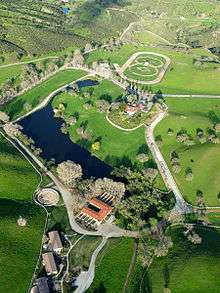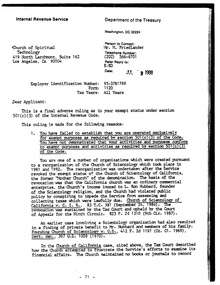Church of Spiritual Technology
|
Logo of the Church of Spiritual Technology | |
| Formation | 1982 |
|---|---|
| Type | Religious |
| Legal status | 501(c) nonprofit |
| Purpose | Owns and licenses the copyrights to the works of L. Ron Hubbard. |
| Headquarters | Hemet, California, United States |
| Location |
|
Chairman of Religious Technology Center | David Miscavige |
| Mission | Preservation and archiving of L. Ron Hubbard's writings and lectures.[1] |

The Church of Spiritual Technology, also known as CST, is a California 501(c)(3) non-profit corporation,[2] incorporated in 1982, which owns all the copyrights of the estate of L. Ron Hubbard and licenses their use. CST is doing business as L. Ron Hubbard Library.[1]
In a 1993 memorandum by the Church of Scientology International, the role and function of CST has been described as follows:
"[...] CST [...] is an autonomous church of the Scientology religion outside of the international Scientology ecclesiastical hierarchy. CST conducts an extensive program of activities to preserve and archive the Scientology Scriptures for use by future generations. CST also owns the option to acquire RTC's rights to the Scientology advance[d] technology and religious marks under three narrowly defined sets of circumstances, each of which contemplates a serious threat to continued existence of the religion. CST is the principal beneficiary of Mr. Hubbard's estate, provided that it obtains recognition of its tax-exempt status. [...]" [3]
Corporate information
The Church of Spiritual Technology (CST) was incorporated by Sherman Lenske in Woodland Hills, California on May 27, 1982.[4] The Bylaws of CST were signed on June 7, 1982 by its General and Special Directors, who were at that time Lyman Spurlock, Rebecca Pook, Maria Starkey, Stephen A. Lenske, Sherman D. Lenske and Lawrence A. Heller. In 1986, CST's Articles of Incorporation were amended to clarify the "disposition of the corporation's assets upon dissolution". On August 18, 1993, CST filed an application for tax exemption under section 501(c)(3) of the Internal Revenue Code. The Internal Revenue Service granted CST's request for exemption through an official recognition letter on October 1, 1993.[5]
At the time of the filing for tax exemption, the following individuals held corporate positions at CST: The Board of Trustees was composed of John Allcock, David Lantz and Russell Bellin. Thomas Vorm, Russell Bellin and Catherine Schmidt formed the Board of Directors. CST's President was Russell Bellin, its Vice-President Thomas Vorm, its Secretary Jane McNairn and its Treasurer Catherine Schmidt.
Licensing of trademarks and service marks

The existence and founding of CST is intimately connected to the creation of the Religious Technology Center, which was incorporated on January 1, 1982. Shortly after its inception, RTC received on May 16, 1982 "the ownership, supervision and control" of the trademarks and service marks, identifying "Scientology applied religious philosophy" and "Dianetics spiritual healing technology" by the originator and founder of Scientology, L. Ron Hubbard through a so-called "Assignment Agreement".
This agreement was subject to an additional "Option Agreement" between Hubbard, RTC and CST. In two so-called "Option Agreements" from May 1982, Hubbard granted CST the right to purchase at any time from RTC the "Marks", the "Advanced Technology" and all the rights to them for the sum of $100.
Parallel and similar-sounding agreements between Hubbard, RTC and CST were created during that period concerning the so-called "Advanced Technology," which consists of unpublished derivates of Scientology's confidential "Advanced technology".
Under these agreements, RTC is forced to turn over 90% of its net income to CST. A document from 1991, reflecting the "financial money flows" of RTC during the year 1989, actually showed a turnover of 59% of RTC's net income towards CST.
Other examples of trademarks and service marks, which are owned by CST are The Way to Happiness and The Way to Happiness symbol. As such, CST operates as the L. Ron Hubbard Library.[6]
Archives
The CST oversees the Scientology scriptural archiving project, which aims to preserve the works of Hubbard on stainless steel tablets and encased in titanium capsules in specially constructed vaults throughout the world.[7] The documents of Hubbard’s works go through a rigorous process of first, ridding the paper of deterioration-causing acid, then placed in plastic envelopes. They are then placed in the titanium "time capsules.” The writings are also carved into stainless steel plates, which, according to Church of Scientology officials, can withstand being sprayed with salt water for a thousand years. Hubbard’s taped lectures are recorded again into gold compact discs encased in glass.[8]
The Church places prime value to Hubbard’s volumes of works and because of this has instituted the CST to “engrave the entire corpus of Hubbard’s original texts on steel plates.”[9] The most famous example is the Trementina Base, an underground vault built into a mountainside near Trementina, New Mexico. It is marked by a CST logo visible only from a high altitude and was built in the late 1980s.[10][11] Former members claim that the purpose of CST's archival efforts is to ensure that Hubbard's work survives a nuclear apocalypse and reforms civilization.[12][13] The church believes that these plates will last beyond a thousand years and that Hubbard’s teachings will be vital for "rebuilding civilization," in the event of global turmoil.[9]
Structure
The very first time the Church of Spiritual Technology was mentioned publicly to scientologists was by COB RTC David Miscavige in 2000 on the New Year's event.[14] Its founders included Meade Emory,[15] a non-Scientologist who used to work for the Internal Revenue Service but went into private practice as a tax lawyer. He was hired as a specialist for the complex Internal Revenue Codes. The Church of Scientology International and most Scientology organizations settled with the IRS about 11 years later when the service passed a resolution in 1993 declaring them tax-exempt.
Unlike other Scientology organizations (which require all corporate officers to be Scientologists in good standing), as well as the Scientologist general directors and staff, the Church of Spiritual Technology includes "Special Directors" who are not required to be Scientologists, but who are required to be lawyers "to ensure that CST takes no action to jeopardize its tax-exempt status" (CST vs. IRS, US Claims Court No. 581-88T, June 29, 1992).[16]
See also
- Church of Scientology
- Church of Scientology International
- Dianetics
- List of Scientology organizations
- Religious Technology Center
- Scientology
References
- 1 2 "What is Church of Spiritual Technology?". Church of Scientology. Retrieved May 27, 2015.
- ↑ Letter by the Internal Revenue Service to Flemming Paludan, Regional Director, Danish Tax-Office, Washington, D.C., USA, December 22nd, 1993
- ↑ Summary Description of Other Scientology Organizations - CST (Church of Spiritual Technology), Author's Family Trust, ASI (Author Services Inc.) - CSI Prod. 11-4-93, Bate Stamp: 151412 - 151413, Ex. 1-8, Washington, DC 1993
- ↑ Articles of Incorporation of Church of Spiritual Technology, Endorsed Filed in the Office of the Secretary of State of the State of California, Woodland Hills, California, May 27th, 28th & June 1st, 1982
- ↑ Recognition Letter for 501(c)(3) tax-exempt status - Church of Spiritual Technology, Washington, DC, October 1st, 1993
- ↑ "How to obtain permission to reprint The Way to Happiness booklets" (PDF). The Way to Happiness Foundation International. Retrieved 2006-12-02.
- ↑ Henderson, Bob (1991-07-25). "Vault to get Hubbard's writings". St. Petersburg Times. Retrieved 2007-12-12.
- ↑ http://www.latimes.com/local/la-scientologysided062490-story.html
- 1 2 Cowan, Douglas; Bromley, David (2015). "Wiley Blackwell Brief Histories of Religion". Cults and New Religions: A Brief History. John Wiley & Sons.
- ↑ Leiby, Richard (November 27, 2005). "A Place in the Desert for New Mexico's Most Exclusive Circles". Washington Post. pp. D1. Retrieved July 11, 2012.
- ↑ Cooper, Anderson (2005-12-02). "Inside the Church of Scientology" (Transcript). Anderson Cooper 360°. CNN. Retrieved 2007-09-23.
- ↑ Scientology Leader David Miscavige's Disappeared Wife Shelly: What We Know, The Village Voice, 5 July 2012
- ↑ Scientology's Secret Vaults: A Rare Interview With a Former Member of Hush-Hush "CST", The Village Voice, 6 February 2012
- ↑ New Year 2000 event speech excerpt, by D.Miscavige
- ↑ "George Meade Emory Obituary". Seattle Times. October 12, 2010. Retrieved July 11, 2012.
- ↑ CST vs. IRS - United States Claims Court, June 29 1992
External links
- What is Church of Spiritual Technology? from scientology.org
- CST vs. IRS 1992
- Patents by Assignee Church of Spiritual Technology
